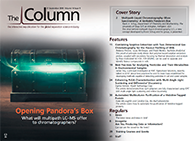Best Practices for Analyzing Pesticides and Their Metabolites in Environmental Samples
When a company wishes to commercialize a new pesticide, they must conduct environmental studies and develop analytical methods capable of detecting the pesticide, and its metabolites, in soil and water samples. The methods must be robust and rugged, for easy use in routine analysis. James Stry, a principal investigator at FMC Agricultural Solutions, recently talked to LCGC about best practices he and his team have established for developing such methods, including approaches to meeting a variety of requirements of regulatory bodies, simplifying sample preparation, dealing with matrix effects, choosing an ionization method, and streamlining method development.
Photo Credit: AOME1812/Shutterstock.com

When a company wishes to commercialize a new pesticide, they must conduct environmental studies and develop analytical methods capable of detecting the pesticide, and its metabolites, in soil and water samples. The methods must be robust and rugged, for easy use in routine analysis. James Stry, a principal investigator at FMC Agricultural Solutions, recently talked to LCGC about best practices he and his team have established for developing such methods, including approaches to meeting a variety of requirements of regulatory bodies, simplifying sample preparation, dealing with matrix effects, choosing an ionization method, and streamlining method development.
Q. When you are developing environmental methods for the registration or re-registration with the U.S. Environmental Protection Agency (EPA) of a new pesticide, what exactly do you have to demonstrate?A: We must demonstrate that the methods we develop extract the environmental residue of concern from soil or sediment and that the residue is accurately quantified. To demonstrate the performance of the extraction method, we treat soil samples with radiolabeled compounds and age them in conditions representative of the environment. Aging the treated soil or sediment allows for the environmental metabolites to form and for the soil to become representative of a sample collected from the environment. We then extract the aged samples and analyze the radioactivity in the extract and the amount of radioactivity remaining in the soil. We test different extraction solvents, extraction techniques (for example, bead mill, sonication, or microwave), and the number of extractions conducted until close to all of the significant residue is extracted from the sample.
Once we have an extraction method, we fortify untreated control soil or sediment samples with known amounts of the analytes of interest. We then extract and analyze these samples and compare the concentration determined using the method to the known amount added to the control samples. The amount determined must be between 70% and 120% of the amount added for the method performance to be acceptable.
Q. In addition to meeting the requirements of the U.S. EPA, do you also have to meet requirements for other regulatory bodies, such as those of other countries, if your products will be sold abroad, or of individual states within the United States? If so, how do you balance meeting all the requirements?A: In an attempt to minimize additional method development work, we develop our methods to meet the most conservative requirements and test our methods on soil collected from all parts of the world. Currently, the European Union (EU) has some of the most conservative requirements for environmental methods. These requirements are described in the SANCO 825 Revision 8.1 guidance document (1). Once validated, the environmental methods can be sent to support compound registrations anywhere. An example is the residue method for chlorantraniliprole in crops (2). This method was validated on 21 different crops at a limit of quantitation of 0.010 mg/kg. This method has been accepted by regulatory agencies around the world for data collection and maximum residue limit (MRL) enforcement.
Q. What are typically the biggest challenges in developing methods for detecting a pesticide and its metabolites in soil or sediment? What are the biggest challenges for detecting them in water?A: Minimizing matrix effects is a major challenge when developing environmental methods. Since our methods are intended to analyze samples from grower fields, a suitable control sample will not always be available. Therefore, preparing standards in untreated control extracts may not always be an option. Moreover, the U.S. EPA prohibits the use of matrix-matched standards in all monitoring and enforcement methods (3).
Developing selective cleanup steps is one way to deal with matrix effects. However, the number and diversity of metabolites in the methods and the low limit of quantitation (1.0 µg/kg or below) makes method development a challenging task. The diversity of metabolites makes it difficult to develop one cleanup procedure capable of removing co-extracts while keeping all of the analytes of interest in a single extract. Keeping all of the compounds in a single extract limits the selectivity of the cleanup procedure.
Developing chromatographic separations using ultrahigh-pressure liquid chromatography (UHPLC) columns or solid-core particles can help minimize matrix effects as well. The sharp peak shape these columns produce lowers the instrument detection level, allowing additional dilution of the extracts. Dilution is perhaps the best way to minimize matrix effects. Instrument manufacturers continue to produce faster, more sensitive, and more rugged instruments that have allowed us to simplify and streamline our methods. The speed of the newest generation of instruments allow for positive–negative switching without significant loss of sensitivity. This capability has removed the need to separate positive- and negative-ionizing compounds chromatographically or to analyze them in multiple chromatographic runs.
Water samples, although less complicated than soil or sediment, can be just as challenging. Water methods usually have a limit of quantitation of 0.10 µg/L or lower. For methods that include many metabolites, the analytes may need to be extracted from the water samples using solid-phase extraction (SPE) or a liquid–liquid partition step. Once the extract is concentrated, a solvent-exchange step may be needed before analysis. At the low levels analyzed in these methods, minor water contaminants can complicate quantitative analysis.
Q. Over the years, have you developed best practices or streamlined approaches to developing these methods?A: When developing the extract purification procedures, we tend to use a systematic approach. Before extracting any samples, we test evaporation and reconstitution steps, liquid–liquid partitions, and SPE procedures. When developing SPE procedures, we filter the analytes through columns in a variety of solvents to determine when they are retained and when they are eluted. Once we retain the analytes on a cartridge, we wash the cartridges with progressively stronger solvents until we have a complete profile of the properties for all analytes. Having all of this information allows us to understand how the analytes behave and to piece together an efficient and effective cleanup procedure.
We prefer to include all of the known metabolites in the methods. If the compound is not detected in the terrestrial field soil dissipation studies or if it does not show any adverse ecotoxicology effects, it can be removed from the method. We refer to this approach as comprehensive method development. We validate our methods in this manner because the addition of a new metabolite to an existing method often results in completely reworking the method, which can be time- and resource-intensive.
Q. In environmental analysis, a challenge is often the complex matrix, which requires effective sample cleanup and preparation. Do you have “go-to” sample cleanup or preparation approaches for certain classes of products?A: When developing our methods, we usually start with the most difficult soil or water samples. The idea is that if the method works for the most complex samples it will perform well for the other samples. For soil samples, we start with a high clay, high organic matter soil. We have found this combination results in an extract that is very difficult to purify and analyze. For water samples, we usually start with a pond-water sample.
The methods developed are based on the analytes included in the analysis. When developing methods for polar metabolites, some of the reversed-phase polymer SPE cartridges can be very effective at concentrating the sample extracts. We usually try to develop cleanup procedures that complement the separation and detection methods. If we are using reversed-phase LC we will try to develop an ion-exchange cleanup. If we are using an alkyl SPE cartridge (such as C18 or C8) for the cleanup step, we will develop a separation using a phenyl or biphenyl column. The overall goal is to minimize matrix effects by taking advantage of multiple physical-chemical properties of the analytes.
Q. What percentage of your methods use gas chromatography (GC) and what percentage use LC? Has there been any change in recent years in that balance?A: Almost all of the methods we develop are LC methods. Many of our active ingredients are thermally labile, limiting the use of GC analysis. The inclusion of multiple metabolites to these methods also limits the amount of GC analysis we conduct. Often, the metabolites we are analyzing are small polar alcohols or weak acids that are not amenable to GC analysis without derivatization. Although derivatization procedures can be developed, they can be time-consuming and add complexity to the methods. It is also worth mentioning that relative to LC analyses, we have generally observed more severe matrix effects when conducting GC analyses.
Q. What type of mass spectrometry (MS) detection do you typically use?A: We typically use LC–MS/MS detection on triple-quadrupole instruments. Given that we are analyzing a limited number of known compounds using a reference standard, we can set up several multiple-reaction monitoring (MRM) transitions at the retention time of each analyte. In addition to being very sensitive, this approach allows for confirmation and quantitation during a single analysis. An added benefit is the availability of triple-quadrupole instruments in contract and monitoring laboratories. Using similar equipment allows for our methods to be transferred and revalidated at the laboratories performing the analysis with minimal modifications.
Q. When do you use atmospheric pressure chemical ionization (APCI) MS, rather than electrospray ionization (ESI)?A: When developing a new method, we usually start with ESI because it is often more sensitive than APCI. If we determine matrix effects are affecting method performance, we attempt to develop a cleanup procedure that is efficient and effective at minimizing the matrix effects. If, because of the number or diversity of the analytes, the cleanup procedure is not effective, is not rugged, or is very complicated, we switch to the APCI ion source. Although less sensitive, APCI usually does not exhibit the same degree of matrix effects as ESI. Given the reduced sensitivity of APCI, we adjust the injection volume, aliquot factor, or the sample’s final volume to reach the required detection level (2). Not all of the compounds we monitor can be ionized using APCI because of the increased temperature of the ion source and the gas-phase ionization mechanism. For compounds that are not amenable to APCI we return to ESI and look for new extract cleanup steps or better chromatographic separations until a robust method is developed.
Q. How do you balance the need for sample preparation methods that are effective but not overly complicated or time-consuming?A: We need to strike a balance between the amount of sample cleanup, the time required to conduct the analysis, and the overall method performance. Cleanup can be time-consuming and tedious work. However, without adequate cleanup, a method will perform well for only a limited number of sample types because of matrix effects, or could result in false positives as a result of coeluted peaks. Reducing sample cleanup in favour of longer chromatographic separations limits the number of samples that can be analyzed per instrument each day.
Because of the large sample size (2–5 g) required to produce a representative soil or sediment sample, we have not implemented the 96-well format or other automated sample preparation approaches. We have seen significant improvements in efficiency using bead mill extractors, however. Bead mill extractors show excellent extraction efficiency of incurred residues and require less solvent per sample, and all of the equipment used is disposable, reducing the probability of sample contamination. The biggest advantage of bead mill extractors is the amount of time required to perform an extraction. An extraction requiring 20–30 min on a wrist action shaker or in a sonicating bath can be completed in 2–3 min using a bead mill.
Our goal is to develop a method with an efficient and rugged cleanup procedure and a set of chromatographic conditions that allow for adequate sample throughput without compromising the accuracy of the analysis.
References
- European Commission, Directorate General Health and Consumer Protection. “Guidance Document on Residue Analytical Methods,” SANCO/825/00 rev. 8.1, 16 November 2010.
- J. Grant, C.A. Rodgers, C.D. Chickering, S.J. Hill, and J.J. Stry, J. AOAC Int. 93(4), 1293–1301 (2010).
- U.S. EPA Ecological Effects Test Guidelines: OCSPP 850.6100: Environmental Chemistry Methods and Associated Independent Laboratory Validation.

James Stry is a principal investigator in the Regulatory Analytical Group at FMC Agricultural Solutions. Before joining FMC in 2017, he was with DuPont Crop Protection for 20 years. He is responsible for monitoring the global regulatory environment as it pertains to the residue and environmental analysis of crop protection compounds. In addition, he also maintains an active laboratory programme developing new residue and environmental methods to meet regulatory requirements. Stry graduated from the State University of New York at Buffalo (USA) with a Ph.D. in physical chemistry.
E-mail: James.J.Stry@dupont.com

New Method Explored for the Detection of CECs in Crops Irrigated with Contaminated Water
April 30th 2025This new study presents a validated QuEChERS–LC-MS/MS method for detecting eight persistent, mobile, and toxic substances in escarole, tomatoes, and tomato leaves irrigated with contaminated water.
University of Tasmania Researchers Explore Haloacetic Acid Determiniation in Water with capLC–MS
April 29th 2025Haloacetic acid detection has become important when analyzing drinking and swimming pool water. University of Tasmania researchers have begun applying capillary liquid chromatography as a means of detecting these substances.

.png&w=3840&q=75)

.png&w=3840&q=75)



.png&w=3840&q=75)



.png&w=3840&q=75)











